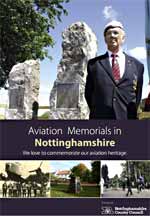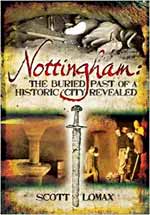Book reviews, Summer 2014
GOING TO THE PICTURES: A short history of Cinema in Nottingham. Michael Payne. 2014, Nottingham Civic Society, ISBN 978-1-902443-12-6 £4.99

This very well illustrated book is obviously a labour of love. Michael has spent a year transforming a passionate idea into reality. There is a brief, nostalgic Foreword by Stephen Frears that really sets the mood for this book; it triggers off memories and cosy nostalgia.
There are seven chapters followed by a Gazetteer of Nottingham cinemas and a short bibliography. Michael’s assemblage of illustrations is first class. The opening chapter is Fairgrounds, Music Halls and Shops, and its first photograph is of Wadbrook’s Royal Electograph in front of the old Exchange c.1899 with Watson Fothergill’s new Queen’s Chambers of 1897 in the background. The last chapter, Modern Times (a nod to Charlie Chaplain 1936?) has photographs of Cine World with its 14 screens under one roof and, of course, Broadway Media Centre on Broad Street.
The illustrations are an intriguing mixture of old and new photographs of cinemas - some as built, some as altered for a change of use, film posters and cinema advertising. In particular the Elite on Parliament Street is deservedly given special treatment with six coloured illustrations from the brochure prepared for its ceremonial opening on 22 August 1921 being reproduced.
Michael points out that of the forty or more cinemas that once existed in Nottingham only the Savoy on Derby Road is still operating. In the 1930s 20 new cinemas were built in Nottingham, 18 of which were in the suburbs. The seating capacity in the city centre cinemas increased from 1,477 in the Elite to 2,426 in the Odeon, Angel Row; even the Carlton (ex ABC etc.), Chapel Bar opened in October 1939 just after the war started could offer 2,077 seats.
For people of a certain age, it does not take long after seeing some of Michael’s pictures for the foodgates of memory to open. “I saw that, but where, when and with whom?”
Michael’s book is warmly recommended, take a trip down memory lane; recall when Going to the Pictures was a way of life. It was where “... people in the dark dreamed dreams before a magic silver screen.”
Ken Brand
AVIATION MEMORIALS IN NOTTINGHAMSHIRE. Newark Air Museum. 2014

This 34 page fully colour illustrated booklet is published by the Newark Air Museum which is situated on the old Winthorpe Airfeld at Newark.
The booklet was funded by Nottinghamshire County Council and contains a description and location of all the aviation memorials in the county.
The booklet is very well laid out and most pleasingly printed.
The memorials, including some pub signs, are given a grid reference, the history of what the memorial represents and detailed instructions on acessibility. The latter is important because a few memorial are on private property and some in locked churches.
I noted some proof reading errors but these in no way detract from this booklet which may well provoke many of us to visit the memorials and reflect upon the men who are named thereon and what they did and how they died.
Some of the memorials are celebratory such as the Flying Bedstead sculpture depicting the Thrust Measuring Rig, commonly known as the Flying Bedstead which was developed at Rolls-Royce, Hucknall and which led to the VTOL [vertical take-off and landing] expirements and, eventually, to such iconic aircraft as the Harrier jump-jet, now no longer in commission in the RAF but still used by other Air Forces in the world. This memorial is sited on the roundabout at the junction of the A611 Hucknall bypass and the B6011 Wighay Road.
Another unusual memorial is the Totem Pole in Radcliffe-on-Trent which was handed over to the village in 2013 by the Canadian High Commissioner to honor the RCAF personnel who served at Langar airfeld and who lived in houses built in Radcliffe on St. Lawrence Boulevard.
In total 40 memorials are listed.
The booklet is free and obtainable from the Newark Air Museum which, as a museum in Nottinghamshire, greatly rewards a visit, and also from some Tourist Information offces. There is much local interest to be found there with a display of the history of Winthorpe airfield as well as other aviation displays and, of course, an extensive set of aircraft shown both outside and within two large hangars. As a bonus there is a café where very cheerful volunteers serve good coffe and hand-made sandwiches!
HF
THE PORTLAND WAY, An Early Nineteenth Century Nottinghamshire Railway and the Collieries It Served. Martyn Taylor-Cockayne and Stuart Saint with chapter 11 by Denis Hill. The Portland Path Project, 2012. ISBN: 978-0-9572416-0-2. £4.95
This softback A4, 68 page illustrated booklet has been sitting on my ‘To Read’ stack for quite some time, to my regret.
The Portland Path Project’s objectives are ‘The exploration, preservation and awareness raising of the network of historic railways/tramways and collieries that made up the Portland colliery complex, specifically including the wharf at Jacksdale, the remains of the collieries at Kirkby-in-Ashfeld and the connecting railways/tramways.
The Project has produced a leafet showing a walk that can be followed covering the various sites, an academic standard book which is said to be available at various archives, and this booklet. The booklet is intended to add to the information contained in the path leaflet and certainly adds to the enjoyment and understanding of the various sites.
I will get my niggles out of the way at the start of this review. The layout of the book is not to my taste; the font used is quite large, and the short paragraphs with wide inter-spacing create the impression of a series of notes rather than a coherent text. Some of the colour illustrations are printed very darkly and several of the old map reproductions are so dark as to make following them very difficult: these are matters which could, and in my view, should, have been dealt with at proof stage and they could quite easily have been adjusted to be printed lighter before the final print run.
The pleasure of reading a publication is enhanced by good presentation and, for me, this booklet fails in this regard.
Having said this the book is very useful and the information adds to knowledge of the period it covers and the history of the area.
There is an inextricable link betwen the collieries, the early railways and the Butterley Company’s ironworks in the Codnor Park area. A visit to the sites is greatly enhanced by the information contained in this booklet. There is a great deal of history in this part of the Nottinghamshire/Derbyshire border and the work of the Portland Path Project has greatly increased knowledge of the area’s rich history. A visit to the area is highly recommended, but before doing so do obtain the path leafet and, if possible, a copy of this book - without them you will be the poorer and not understand much of what you will see.
The book contains many illustrations, many in colour which, together with the maps and diagrams, help to explain the area and the technical aspects of the industries dealt with. The areas covered by the booklet are not, perhaps, on a regular tourist trail but for any local or industrial historian they are a must place to visit. In 2013 the Society had a full day excursion to Ashfeld during which we saw the area and greatly beneftted from Denis Hill’s guidance. Denis’ post at Ashfeld RDC has been lost due to the economic cutbacks in local government which is to be regretted and will not encourage people to visit. Hopefully this booklet can be made more widely available by the Portland Path Project team and this should encourage more of us to learn about and value the heritage of this part of our county. Do seek out the booklet and buy it.
HF
Nottingham: the buried past of a historic city revealed. Scott Lomax; Pen and Sword; ISBN 978-1781593892. £12.99

This is a newish (October 2013) book on Nottingham’s history, a history which is often viewed through a very narrow focus of Robin Hood, lace, bicycles, raising the Standard and, for many non-Notts people, not much more.
Scott Lomax has managed to fit into this smallish book a great deal more of the fascinating history of our city. Its main thrust is the archaeological investigations and excavations carried out by amateur and professional archaeologists over the last century and this one, and also includes antiquarian accounts of the city. It covers many of the most interesting discoveries in the historic centre of Nottingham, including the Danish connections, the elusive friaries, Civil War graffti - right up to attempts to reconstruct the castle!
Easy to read and informative, it’s certainly something worth having on our bookshelves.
It is unfortunate that the publishers did not inform us of this book nearer the publication time - I only found out about it when it was reviewed, with a good write-up, in Current Archaeology. But, of course, it is still available from the usual sources.
Barbara Cast
BRIDGES Heroic Designs that Changed the World. Dan Cruikshank. Harper Collins. ISBN 9780-00-731828-6

This is not a book about local history and certainly not about Nottinghamshire with no bridge in our county being mentioned. It is rather a wide ranging survey of bridges world wide which the well known TV personality author has visited and researched. It is a fascinating story of bridges, their histories and many of the stories behind the construction and, indeed, their designers and builders throughout the world.
The book is reviewed here because it is consider that many members with an interest in Bridges will fnd it of great interest.
The author has visited many, if not all of those covered. In telling the stories about them he also gives the history of the societies in which they were built and the history of methods of bridge design from earliest times to the present day. The many illustrations and diagrams help the reader’s understanding of the text and the details of construction.
The book has 384 pages including an extensive index and a four page bibliography. Many of the bridges described will be familiar to the reader from photographs and, perhaps from personal visits. I have certainly seen several, notably the Roman aqueduct in Segovia, Spain, the Pont du Gard in France, the bridges in Florence, Venice and Strasbourg as well as those over the Tyne in Newcastle. I have learned more about them from this book than from the local guide books I have bought and have therefore appreciated them to a much greater extent.
This book is thoroughly recommended for its scholarship and accessible writing by a man whose TV presentations are always enjoyed. Do borrow it from your local library, you will enjoy the read.
HF